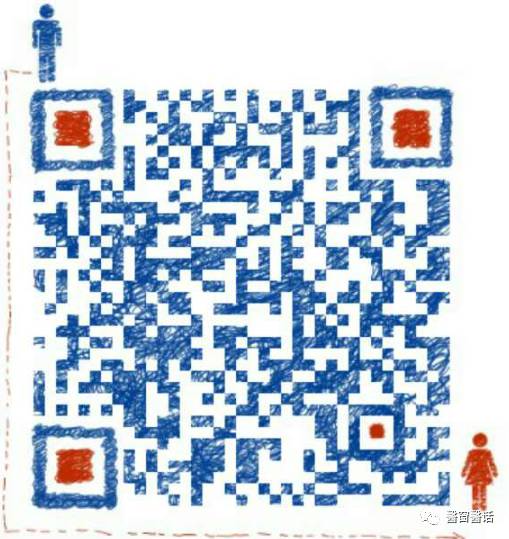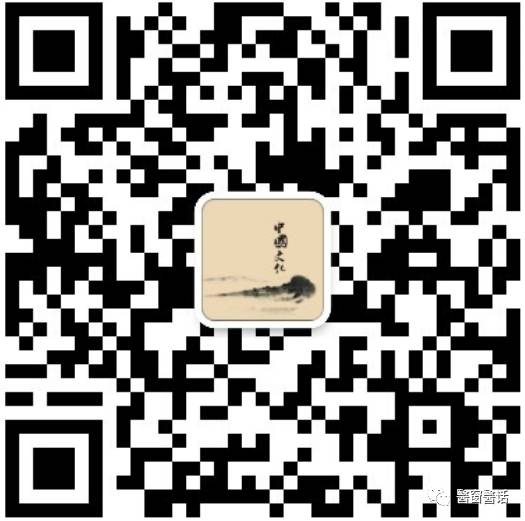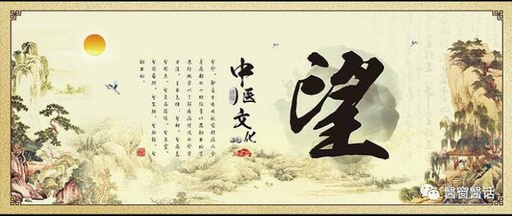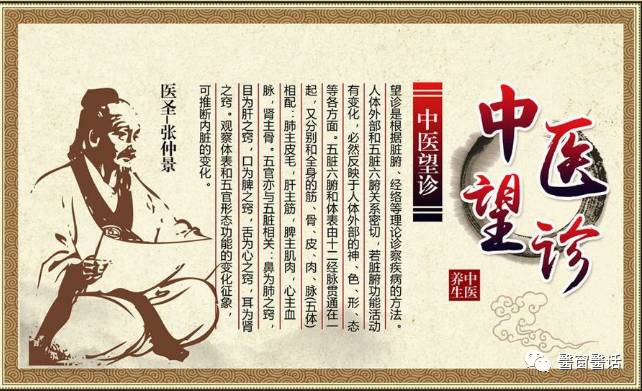
Observation Diagnosis (Wang Zhen) is a method of diagnosing diseases based on the theories of the internal organs (zangfu) and meridians. The external aspects of the human body are closely related to the five internal organs. If there are changes in the functions of the internal organs, it will inevitably be reflected in various aspects of the body’s external appearance, such as spirit (shen), color (se), shape (xing), and posture (tai). The five internal organs and the body surface are interconnected through the twelve meridians, and they correspond to the body’s muscles, bones, skin, and flesh (the five bodies): the lungs govern the skin and hair, the liver governs the tendons, the spleen governs the muscles, the heart governs the blood vessels, and the kidneys govern the bones. The five sensory organs are also related to the five internal organs: the nose is the orifice of the lungs, the eyes are the orifice of the liver, the mouth is the orifice of the spleen, the tongue is the orifice of the heart, and the ears are the orifice of the kidneys. Therefore, by observing changes in the external body and the functions of the sensory organs, one can infer changes in the internal organs. This method can also reflect the overall balance of vital energy (qi) and essence (jing). Changes in essence, qi, and spirit are primarily manifested in the head and eyes, and also reflected in the overall body shape, speech, breath, facial complexion, and even pulse and tongue appearance. A full essence, sufficient qi, and vibrant spirit are signs of health; while deficiency in essence, qi, and spirit are manifestations and causes of disease. Thus, observation diagnosis can not only assess internal organ pathologies but also understand the dynamic changes of essence, qi, and spirit in the body.
Overall and Partial Observation Diagnosis
Overall observation diagnosis involves observing the spirit, color, shape, and posture of the entire body, while partial observation diagnosis focuses on local changes to understand related pathologies. In clinical practice, there is no strict distinction between overall and partial observation diagnosis. The specific steps can begin with overall observation followed by a systematic partial observation.
Observing Spirit
Observing spirit focuses on the gaze, facial expressions, and mental activity, which are important for assessing clinical prognosis and life activities.
Observing Facial Color
Observing facial color primarily involves changes in the complexion, including the five colors of blue, red, yellow, white, and black, which can reflect the fluctuations of qi and blood in the internal organs and the location of pathogenic factors.
Observing Shape
Observing shape involves diagnosing by examining the patient’s body shape and posture.
1. Observing Body Shape
This primarily involves observing the strength, weakness, and body shape of the trunk and limbs. Body shape characteristics generally reflect the yin-yang and qi-blood constitution of the individual. For example, slender individuals often have yin deficiency and yang excess, while short and stout individuals may have yang deficiency and yin excess. Those who are neither overweight nor underweight and have a moderate height typically have a balance of yin and yang. Additionally, body shape can also reflect the nature of pathogenic factors; for instance, overweight individuals often have phlegm, while thin individuals may have excess heat. The shape of the trunk and limbs also has diagnostic significance; conditions like pigeon chest and hunchback often indicate congenital deficiencies or postnatal malnutrition due to kidney essence deficiency or spleen and stomach weakness. A barrel-shaped chest may indicate phlegm accumulation leading to cough and asthma, while a distended abdomen with thin limbs may indicate ascites.
2. Observing Posture
This involves observing the patient’s movements and static postures. For example, trembling of the lips, fingers, and toes may indicate heat disease with wind, while internal injuries may indicate blood deficiency and yin deficiency. Spasms and convulsions of the limbs, stiffness of the neck and back, and arching of the back are often seen in convulsive diseases, commonly associated with internal wind or excessive heat. Abnormalities in limb movement and various pain symptoms can also be inferred from posture. For instance, weakness and lack of pain in the limbs may indicate atrophy syndrome; swollen and painful joints may indicate bi syndrome; inability to move the limbs, numbness, rigidity, or weakness may indicate paralysis; holding the abdomen while leaning forward may indicate abdominal pain; holding the waist while bending and having difficulty turning may indicate low back pain. Furthermore, posture can also reflect the patient’s behavioral intentions related to their condition. For example, shrinking away from clothing indicates aversion to cold, suggesting exterior cold or interior cold syndrome; wanting to uncover oneself indicates aversion to heat, suggesting exterior heat or interior heat syndrome; desiring to see people while preferring coolness often indicates a yang syndrome; fearing to see people while preferring warmth often indicates a yin syndrome. The sitting or lying posture can also provide insights into the dynamics of yin and yang and the balance of righteous and pathogenic factors. For instance, curling up while lying down and preferring to be enclosed often indicates yang deficiency and cold syndrome; lying exposed and preferring to be open often indicates yang excess and heat syndrome; preferring to lean forward while sitting may indicate lung deficiency and shortness of breath; preferring to lean back while sitting may indicate lung excess and qi counterflow.
Observing the Head, Face, and Neck
The head, face, and neck are where the governing vessel (Du Mai), conception vessel (Ren Mai), and the three yang meridians of the hands and feet converge. The liver meridian also ascends to the head. The brain, located within the skull, is the center of mental activity. The brain is considered the sea of marrow, governed by the kidneys. The heart governs the blood vessels, and the blood vessels nourish the face, hence the heart’s essence is reflected in the face. Therefore, observing the head, face, and neck can provide insights into the qi and blood status of the internal organs. In fact, observing spirit and color primarily focuses on the head and face.
1. Observing the Head
An excessively large or small head may result from congenital developmental issues or kidney essence deficiency. A sunken fontanelle in children is termed “sunken fontanelle,” while a delayed closure of the fontanelle is termed “open fontanelle,” both indicating congenital insufficiency or brain marrow deficiency. A bulging fontanelle in children is termed “bulging fontanelle,” often caused by warm disease and heat invading, indicating a solid condition. Involuntary head shaking may indicate wind disease or insufficient qi and blood. Sparse and dry hair indicates deficiency of essence and blood, while premature graying in youth suggests kidney deficiency or blood deficiency. A tufted appearance in children’s hair may indicate malnutrition.
2. Observing the Face
This focuses on the expression and color of the face. For instance, facial swelling indicates edema occurring in the eyelids and face; redness, swelling, and heat in the facial skin often indicate wind-heat or fire toxin invading; facial muscle paralysis, leading to crooked mouth and eyes, may indicate wind evil obstructing the collaterals or deficiency in the collaterals, often associated with the yangming meridian.
3. Observing the Neck
Stiffness in the neck may be a symptom of convulsive disease, often caused by excessive heat or internal wind. Weakness in the neck may fall under the category of the five soft conditions in children (soft head, soft neck, soft hands, soft feet, soft muscles), indicating congenital insufficiency or kidney essence deficiency. If there are lumps in the throat area, such as goiter, that move with swallowing, it may indicate goiter, often due to liver qi stagnation and phlegm accumulation, or related to local environmental factors.
Observing the Five Sensory Organs
The five sensory organs (eyes, ears, nose, mouth, tongue) are related to the qi and blood status of the five internal organs. Observing changes in the spirit, color, and shape of the five sensory organs can directly assess internal organ pathologies.
1. Observing the Eyes
The eyes are the orifice of the liver, and the essence and qi of the five internal organs converge in the eyes. The five related areas of the eyes are referred to as the five wheels (see five wheels and eight directions), thus observing the eyes can assess both spirit and internal organ pathologies. Clear distinction between the white and black of the eyes, clear vision, and a lively spirit indicate good health; while cloudy whites, stagnant black, and lack of spirit indicate more severe conditions. Redness in the eye corners may indicate heart fire, pale white may indicate blood deficiency; red whites may indicate lung heat, yellow may indicate internal damp-heat; swelling of the eyeballs may indicate liver fire; redness and ulceration of the eyelids may indicate spleen fire; overall redness and swelling of the eyes may indicate wind-heat; dark coloration of the eyelids may indicate kidney deficiency. Swelling of the eye sockets may indicate early signs of edema, while sunken eye sockets may indicate exhaustion of the internal organs’ essence and qi; protruding eyeballs may indicate goiter. Changes in pupil color, presence of membranes, and unclear vision may indicate cataracts or other eye diseases. If the pupils dilate, it may indicate exhaustion of kidney essence, often seen in critical conditions, or internal wind cataracts and certain poisonings; if the pupils constrict, it may indicate excessive liver and gallbladder fire, or internal heat disturbance, or poisoning. Drooping eyelids, termed “eyelid failure,” may indicate congenital insufficiency or deficiency of the spleen and kidneys, and may also result from trauma. If the eyes roll upward or stare straight ahead, it often indicates a severe condition, commonly seen in children with spleen deficiency or chronic wind.
2. Observing the Ears
The ears are the orifice of the kidneys and are also where the three yang meridians converge. Observing the ears primarily involves examining the color, shape, and discharge from the ear.
3. Observing the Nose
The nose is the orifice of the lungs and is associated with the spleen meridian, connecting with the stomach meridian. A blue nose tip may indicate abdominal pain, yellow may indicate damp-heat, white may indicate blood loss, red may indicate heat in the lungs and spleen, and dark may indicate water retention. Dry nostrils often indicate yangming heat syndrome. Flaring of the nostrils initially indicates wind-heat obstructing the lungs, while prolonged flaring may indicate insufficient lung qi. Additionally, observing the nose can provide diagnostic insights into conditions such as nasal polyps, alcoholic nose, leprosy, and syphilis.
4. Observing the Mouth and Lips
The spleen opens to the mouth, and its essence is reflected in the lips. Healthy lips are rosy, indicating harmonious qi and blood and abundant stomach qi. Pale lips may indicate blood deficiency, light red may indicate cold deficiency, deep red may indicate excess heat, and dark blue may indicate qi stagnation and blood stasis. Cracked lips may indicate insufficient body fluids, while drooling at the corners of the mouth may indicate spleen deficiency or stomach heat. Furthermore, observing the mouth and lips can provide direct clinical significance for conditions such as oral ulcers, canker sores, angular cheilitis, and chapped lips.
5. Observing the Tongue
The tongue is the orifice of the heart and is directly or indirectly connected to the five internal organs through meridians and tendons. Observing the tongue primarily involves examining the tongue body and coating.
6. Observing the Gums and Teeth
The kidneys govern the bones, and the teeth are considered remnants of the bones. The hand and foot yangming meridians connect to the gums and teeth. Therefore, observing the teeth and gums can provide insights into kidney and gastrointestinal diseases, especially significant for diagnosing warm diseases. In healthy individuals, teeth are white and moist, and the roots are firm, indicating abundant kidney qi and body fluids. If the teeth are dry, it may indicate excessive heat damaging body fluids; if they are dry and hard like stone, it may indicate excessive yangming heat; if they are dry and brittle like withered bones, it may indicate kidney yin deficiency. Loose or sparse teeth and exposed gums often indicate kidney deficiency. Pale gums may indicate blood deficiency, while receding gums may indicate stomach yin deficiency or kidney deficiency, and swollen gums may indicate stomach fire. Bleeding gums that are painful and red may indicate stomach heat, while painless and slightly swollen gums may indicate kidney deficiency or qi deficiency.
7. Observing the Throat
The throat is a vital passage for breathing and eating, related to the lungs and stomach. In healthy individuals, the throat appears pink and moist, and is unobstructed. If the throat is ulcerated and surrounded by redness and swelling, it often indicates a solid heat condition; if the tonsils are ulcerated and suppurating, it may indicate a condition of lung and stomach heat. If the ulcerated area is covered with a white membrane resembling a film, it is termed a pseudo-membrane. A pseudo-membrane that is tough and difficult to remove often indicates diphtheria.
Observing the Skin
The skin is the body’s exterior, where defensive qi circulates, and it is internally connected to the lungs. It plays a role in sweating, regulating body temperature, and defending against external pathogens. The essence and qi of the five internal organs circulate through the meridians to nourish the skin, maintaining its warmth, moisture, and normal function. Therefore, observing the color and shape of the skin can provide insights into the nature of pathogenic factors and the status of qi and blood in the internal organs.
1. Observing Skin Color
The principles and methods are similar to observing facial color. Generally, a moist skin color indicates that the essence and qi of the internal organs are still strong, and even if there is illness, it is easier to treat; while dry, dull, and lackluster skin indicates deficiency of essence and qi, suggesting a more severe condition. Diseases that can be effectively diagnosed through skin color include erysipelas and jaundice. If the skin appears red as if dyed with vermilion, it may indicate erysipelas. If the entire skin presents a cloud-like red color, fluctuating or swollen and painful, it is termed red traveling erysipelas, often caused by wind-heat invasion, excessive heart fire, or fetal toxin in children. If it occurs locally, it is termed flowing fire; if the lower limbs are red and swollen, it may indicate damp-heat and fire toxin descending; if the skin on the head and face is red, swollen, and painful, it may indicate wind-heat toxin invasion. If the skin, face, eyes, and nails appear abnormally yellow, it may indicate jaundice. Among them, bright yellow like orange indicates yang jaundice, caused by internal damp-heat; dark yellow like smoke indicates yin jaundice, caused by cold dampness obstructing the spleen; if the skin appears yellow with a dark hue, it is termed black jaundice, caused by blood stasis or kidney deficiency.
2. Observing Skin Shape
Abnormal skin shapes include swelling, rashes, and blisters. Swelling in the head, face, chest, abdomen, waist, back, and limbs, with tight skin that leaves a dent when pressed, is termed swelling, caused by internal water retention or external overflow into the skin; if the skin is floating and leaves a dent when pressed, it indicates qi stagnation. Rashes appear as patches on the skin, which do not feel solid to the touch, and can be classified into yang rashes and yin rashes. Yang rashes, also known as eruptive rashes, are large patches that are red or purple, and may even be dark purple, often accompanied by fever, irritability, delirium, thirst, red tongue, and rapid pulse, commonly seen in externally contracted warm diseases or heat entering the blood. Yin rashes vary in size, are light red or dark purple, and are hidden and not prominent, appearing unpredictably, with the patient being clear-headed, cold limbs, diarrhea, pale tongue, and thin pulse, often due to internal injury from qi and blood deficiency. Eruptions from the skin’s blood vessels appear as small, red, raised spots, commonly seen in measles and rubella, characterized by small, raised papules. Generally, rashes that are evenly distributed and sparse, with a red and moist color, indicate a favorable condition; while dense spots or tightly clustered roots with a deep color indicate a more severe condition. White spots are small, raised vesicles containing fluid, often seen in summer heat or damp-heat patients, indicating internal dampness and insufficient sweating. Blisters are raised areas of varying sizes containing fluid, seen in conditions like chickenpox, herpes zoster, and eczema. Additionally, there are also signs of skin changes such as carbuncles, abscesses, boils, and furuncles.
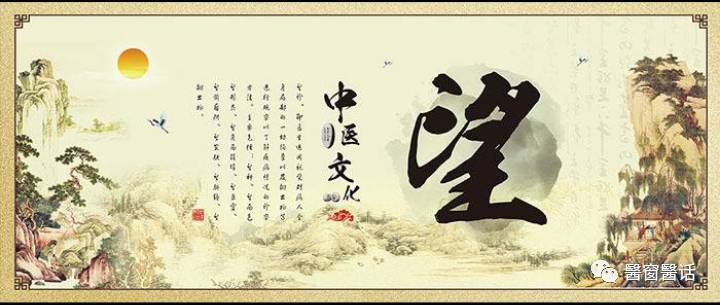
Observing the Pulse and Vessels
This involves diagnosing diseases through changes in the color and shape of the pulse at the fish joints, index fingers, and fingernails.
1. Observing the Index Finger Vessels
Also known as observing children’s fingerprints, this is primarily used for children under three years old, focusing on changes in shape, color, thickness, and length. The appearance and distribution of the index finger’s palmar vessels can be divided into wind, qi, and life vessels. During examination, the doctor uses the right thumb to apply moderate pressure from the life vessel towards the qi and wind vessels, repeatedly, until the vessels become more visible for observation. Normal fingerprints are bright red, with a combination of red and yellow, and are often slanted and single, with moderate thickness. Dark color indicates severe illness, while light color indicates mild illness; pale color often indicates deficiency, while stagnant color (difficult to push and slow to return) often indicates excess; light red often indicates cold, while dark red often indicates heat; dark purple indicates blood stasis and is critical; blue indicates wind or pain. If the vessels are superficial and visible, the disease is superficial; if they are deep and hidden, the disease is internal. Thick vessels indicate solid or heat conditions, while thin vessels indicate deficiency or cold conditions. Gradual growth indicates worsening of the condition, while shortening indicates improvement. The index finger vessels are seen in wind vessels, indicating superficial disease and a milder condition; if they extend to the qi vessels, the disease has progressed inward, indicating a more severe condition; if they reach the life vessels, the disease has penetrated the internal organs, indicating critical illness.
2. Observing the Fingernails
The fingernails are remnants of the tendons and are external indicators of the liver and gallbladder. The liver stores blood and governs the smooth flow of qi, thus observing the fingernails can provide insights into the status of qi and blood. Healthy nails are rosy, shiny, and strong, indicating abundant qi and blood and smooth circulation. Deep red nails indicate heat in the qi level; yellow indicates jaundice, often accompanied by yellowing of the face and skin; pale nails indicate blood deficiency or deficiency of both qi and blood; white nails indicate deficiency and cold; dark purple nails indicate blood stasis; blue nails often indicate cold conditions. If pressing the nails turns them white, and the color takes time to return, it indicates qi stagnation and blood stasis; if they do not return to red, it often indicates blood deficiency. Flat and concave nails, termed “spoon nails,” often indicate liver blood deficiency; dry and brittle nails may indicate liver heat or liver blood deficiency or heart yin deficiency. Thin and brittle nails, often seen in qi and blood deficiency, may also be seen in conditions like wind-evil, nail fungus, or chronic bi syndrome.
3. Observing the Fish Joints Vessels
The fish joints are the fleshy areas at the base of the thumb, where the hand taiyin lung meridian runs, and are related to the qi and blood status of the stomach meridian. Observing the fish joints primarily involves examining color, such as blue indicating cold and red indicating heat. This method is currently less commonly used.
Observing Excretions
This includes observing vomit, phlegm, saliva, nasal discharge, sputum, urine, menstrual discharge, and pus in terms of their shape, color, quality, and quantity.
1. Vomit
Clear, thin, and odorless vomit primarily indicates cold conditions; foul-smelling and sour vomit primarily indicates heat conditions; vomit containing undigested food with a sour odor often indicates food stagnation; clear watery vomit with dry mouth and lack of desire to drink, along with a greasy tongue coating, often indicates phlegm retention. Vomiting yellow-green bitter liquid may indicate liver and gallbladder damp-heat; if vomiting fresh blood or dark purple clots mixed with food remnants, it may indicate stomach heat or liver fire, or the presence of blood stasis.
2. Phlegm
Yellow, thick, and clotted phlegm indicates heat phlegm; white, clear, and thin phlegm with many bubbles indicates wind phlegm; white, clear, and thin phlegm with gray-black spots indicates cold phlegm; white, slippery phlegm that is easy to expectorate indicates damp phlegm; scanty and sticky phlegm that is difficult to expectorate indicates dry phlegm. Phlegm with blood that is bright red often indicates yin deficiency with excessive heat, damaging the lung collaterals.
3. Nasal Discharge
Thick nasal discharge indicates external wind-heat, while clear nasal discharge indicates external wind-cold; persistent thick nasal discharge indicates nasal congestion.
4. Saliva
Excessive drooling from the corners of the mouth, which cannot be controlled, with clear and abundant quality, often indicates spleen deficiency; if the saliva is thick and turbid, it may indicate spleen and stomach damp-heat; excessive drooling in children may be due to parasitic accumulation or stomach heat. Excessive salivation may indicate stomach cold, food stagnation, or kidney deficiency.
5. Urine and Stool
Stool resembling paste indicates large intestine heat accumulation; stool resembling duck droppings and being loose indicates deficiency-cold; sticky stool indicates excessive heat damaging body fluids; dry and hard stool indicates fluid deficiency, while stool containing red and white pus indicates dysentery, and stool containing undigested food indicates food stagnation or spleen deficiency. Dark yellow and turbid urine, or white urine resembling rice water, indicates damp-heat descending; pale and clear urine indicates kidney yang deficiency; red and turbid urine indicates blood in the urine.
6. Menstruation
Heavy menstrual flow with thick quality or blood clots, dark red color, often indicates blood heat; if the flow is heavy, thin, and light red, it often indicates qi deficiency; dark menstrual blood with clots often indicates blood stasis; irregular menstrual flow, whether heavy or light, with varying colors, often indicates liver qi stagnation.
7. Vaginal Discharge
Women may have a small amount of white vaginal discharge. If the discharge is excessive or continuous, it may indicate a discharge disorder. If the discharge is white, it indicates cold-damp; if yellow, it indicates damp-heat; if mixed red and white, it indicates liver damp-heat; if various colors are mixed, it indicates a serious gynecological condition. If the discharge is clear and thin, it indicates deficiency-cold; if thick and sticky, it indicates excess-heat; if resembling saliva, it indicates spleen deficiency with dampness; if resembling pus, it indicates internal abscess.
8. Pus
Pus is a liquid necrotic substance from skin and flesh, often seen in surgical abscesses. If the pus is yellow-white and thick, with bright color, it indicates abundant qi and blood expelling pathogens; if the pus is yellow-white and thin, with clear color, it indicates a favorable condition, showing that the righteous qi is overcoming the evil; if the pus is yellow and turbid, it indicates excessive internal heat; if the pus is green-black and thin, it indicates deep-seated toxic pathogens, suggesting a severe condition.
Copyright Notice: The article is sourced from the internet; please contact us for removal if there is any infringement.
Note: The content of this article is for public welfare sharing in TCM and is for reference only.
